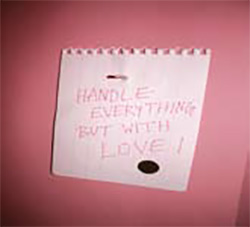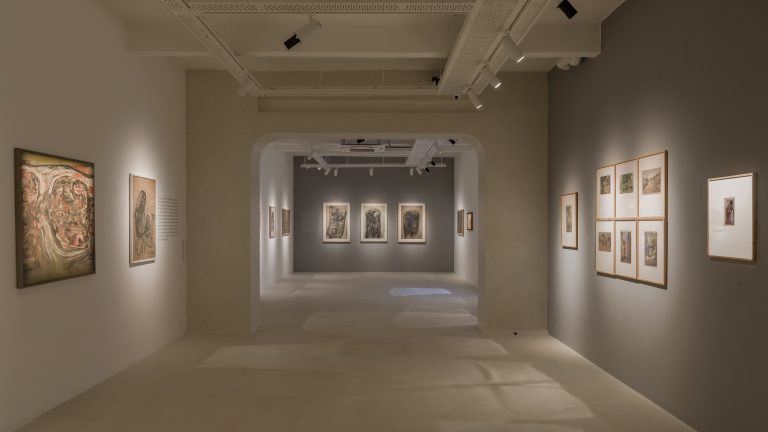In 2007, riding the wave of the Indian art market, Mithu Sen, a young Santiniketan trained artist advertised a ‘Summer Dhamaka’. Select hundred invitees logged onto www.mithusen.com that redirected them to ‘Free Mithu’. Fleshy lips frozen in a permanent leer greeted you; lurid shades of pink- characteristically Mithu- formed the backdrop for an advertisement for free art work! Conversing with Mithu about the genesis of this project, it is easy to believe her when she says that her commercial success led to a complete paradigm shift in her life; while it brought her unprecedented fame and money, it also left a residue of unease. Measuring the worth of art in terms of prices per square foot appeared to corrupt the numen of her work.

A chance reading of Lewis Hyde’s classic book The Gift1 led to ‘Free Mithu’- artwork in exchange of love in the form of a letter. While a gift usually implies the transfer of something without the expectation of anything in return, in ‘Free Mithu’, the ‘gift’ which may be understood as the art work was instead the artist’s numen; and in an act of reciprocity, a barter was established: art work/ a bit of Mithu in exchange for love. In order to explore the many tropes that the project contains- of generosity, commodity exchange, gratitude, this essay refers to Hyde’s propositions in unpacking Mithu’s project. First published in 1983, The Gift underlines the value of creativity in a context that is increasingly driven by a commodity-market economy. Using an anthropological approach, Hyde deconstructs the notion of gift making; he makes a distinction between the inner gift of creativity that every artist has- that “we accept as the object of our labor, and the outer gift that has become a vehicle of culture. I am not concerned with gifts given in spite or fear, nor those gifts we accept out of servility or obligation; my concern is the gift we long for, the gift that, when it comes, speaks commandingly to the soul and irresistibly moves us.” Hyde speaks further about the transformative qualities of a gift that has a deep impact on the recipient. The recipient in turn must aspire towards that gift; he/she must engage in a labour of sorts that allows the transformation to take effect.

Taking a cue from this, Mithu invited a hundred of her acquaintances to write her a letter of love in exchange for a unique artwork made especially for them. (The website stated: “Dear… I would love to give you one of my art work as a gift if you lovingly respond with a letter…with love… BY POST… at the address above” “Original art work done by me. Unique edition. Select style from Gallery”). Each of these hundred could further extend the offer to another person, who Mithu may or may not know, but would send her a letter of and with love, in exchange for an artwork. The riders were few: the letter could not be emailed, the recipient could do what they wanted with the art- burn it, sell it or keep it! While it may appear odd to invite strangers to express their love to you, the idea is rooted in Hyde’s “gift economy”, wherein he speaks of works of art existing simultaneously in both the market and the gift economies. “Unlike the sale of a commodity, the giving of a gift tends to establish a relationship between the parties involved… it is this element of relationship… gift exchange as an ‘erotic commerce’, opposing eros (the principle of attraction, union, involvement which binds together) to logos (reason and logic in general, the principle of differentiation in particular) a market economy is an emanation of logos.” Joseph Conrad writes about how “the artist appeals to that part of our being… which is a gift and not an acquisition- and, therefore, more permanently enduring.”
The “relationship” as it were manifested in the form of letters, postcards and gifts that were sent to Mithu; these included jewelry, crates of mangoes, a personal sweater that Mithu had liked, to intangible gifts such as the insistence to meet for a few hours over tea and lemon cake that allowed Mithu the time away from the stress of preparing for a major solo show. Interestingly, many did not respond, at least not until Mithu announced the culmination of the project two years later, in February 2009, at which there was a surfeit of hitherto missing letters! Participants could choose the style of their art: on the website a tiger skin covered hot-water bottle uncorked the gallery which included hair sculptures, site-specific sculptural installations, a tattoo on the hand (similar to the one Mithu sports), a Balinese poem and, the most popular, drawings of paper. Invitees had to register on the website; including quirky details such as what they considered precious in life, what they would choose as an alternative profession, their choice between a jackfruit and Bollywood film-star Shahrukh Khan (he was the only one who got a gift without a love letter. A drawing wrapped in brocade was the centre piece of one of the displays at the Khoj Studios – Mithu intended to have this delivered to the actor’s residence), whether they had a family physician and whether they believed art should be affordable to all. The first lot of questions created an artificial ground for the creation of a supposed intimacy based on these ‘revelations’ between the artist and the participants. In the interaction and exchange, a relationship is built between the artist and the participants; with the success of the project depending on the basic premise of a gift exchange subsists in an “economy of small groups”.
Two years in the making, the project culminated at the Khoj studios in Delhi in February 2009. The choice of Khoj itself was significant as it is one of the rare non-commercial spaces which focus on process-based art practices. The gift economy on which ‘Free Mithu’ was based, the free exchange, which subverted the art market that functions on the notion of exclusivity and scarcity of the precious object, aligned with the curatorial premise of Khoj.

Three studios were converted into exhibition/ interactive spaces wherein participants were invited to ‘witness’ the project. The display aesthetics were carefully formulated in a way that allowed the project to extend seamlessly from its web-presence and individual interactions into a physical community space. Painted in the pink tones of the website, the sites were converted into installations, in the typical manner that Mithu works. Beaded curtains hung in the doorways, sets of gloves on the windows matched instructions to handle everything with love. All the ‘gifts’ that were received were also on display, boxes brimming over with correspondence, precious stones, perishable fruit, handkerchiefs and also a copy of the book from which the idea germinated- Lewis Hyde’s The Gift, placed on a glass shelf along with a biography of Shahrukh Khan and books by Virginia Woolf- texts that had an impact on Mithu. The letters that Mithu received over two years were neatly tucked into transparent sleeves of file folders could be read, but not identified as some of the sender’s names had been concealed on request. Where some had written a brief paragraph in anticipation of the gift they would receive in return, some exceeding their brief sent many postcards over two years. The community created over two years was expanded again- where four “lucky/ unlucky” winners would get mixed media works on paper (the only art works that could be seen in the display) via a lucky draw. Another studio allowed visitors to write a letter to Mithu ‘on the spot’; ten of these would be selected for “gifts” of art works.
The participants were invited to collect the works made for them. These were placed along a long wall in pink floral pillowcases, which were converted into bags by a local tailor. The artworks were seen only as part of a looped projection that interspersed images with selected bits of texts from letters and responses on the website. Mithu explained she had deliberately concealed the “gifts” as a democratic gesture towards the recipients. However, reactions on the ‘open studio day’ naturally included comparisons of art work-based mostly on size; the dimensions echoing the love that Mithu felt and was willing to give!

The spectacular public nature of the culmination of the project has to be viewed in the context of Mithu’s previous projects. In 2006, when ‘It’s Good to be Queen’ opened in New York, where Mithu had lived for more than two months on a residency, bemused visitors waited in vain for the artist, who had chosen instead to spend the night traveling around the city on the terrace of an open-air bus. Everything was on display – the sheets Mithu had slept on, the clothes worn the previous night, used tea bags left over from interactions with numerous visitors, and the drawings she made while living in the apartment. Her life and her art were indistinguishable and inseparable. It was through the objects in the apartment and through the art, that Mithu wanted her presence felt and communicated. Mithu writes (personal email correspondence) about the tropes of “guest-host-hospitality-tolerance” that were contained in ‘It’s Good to be Queen’; it is these that are taken forward in Free Mithu, where the artist self professedly has taken the project forward as a mode of mapping human psychology, both hers and the gift recipients’. Mithu also found inspiration in Vivan Sundaram’s 2005 landmark project ‘living. it.out.in.delhi’, in which drawings were sold for Rs. 999/-. In a newspaper interview2, Sundaram said, “pricing my drawings at Rs. 999/- is a playful comment on the art market. I can’t stop it but can reflect on the games that go on. I’m also indulging in a game.”
Art historian Beth Citron gave words to Mithu’s ideas, writing about how ‘Free Mithu’ drew “on tropes of hospitality, giving, exchange, and tolerance”3, contained in ‘It’s good to be Queen’, delving into fragile notions of sincerity, generosity, and the conditional meanings of “free” and “gift”. Citron draws a historical lineage between ‘Free Mithu’ and earlier projects such as the one by Taiwanese artist Lee Ming Wei who worked to subvert the commodification of art in a market economy. Indeed, also in ‘Free Mithu’, the commercial value of the ‘gift’ was never forgotten as each artwork came with an authenticity certificate and its current “retail price” in the market.

‘Free Mithu’ constructed a mythology of heroism around Mithu’s act of generosity. In the context of the spiraling market economy for Indian contemporary art and Mithu’s placement in that upward graph when the Summer Dhamaka was announced in 2007, with more than a hundred of her works potentially flooding the market, the artist ran the risk of undercutting her own commercial worth. In 2009, with the slump in the commerce of art, the project was overlaid with a somber retrospection of the nature of art, its commodification, and the artist’s obligation to their own ‘gift’. As soon as the gift is accepted, it runs the risk of being transformed into a commodity as soon as it was accepted, to be compared, commented on and even disliked by the recipient. Hyde makes reference to Marcel Mauss’ classic work on gift exchange, Essai sur le don (France, 1924) in which Mauss speaks of the three related obligations that mark gift economies: “…the obligation to give, the obligation to accept, and the obligation to reciprocate.” The obligation of gratitude that is thrust upon the ‘giftee’ was a hidden subtext that forms part of the duties of the recipient.
The project continues as Mithu still receives emails and letters from people who are keen to partake of the ‘free’ art. Reactions from the original recipients have ranged from refusals to accept the artwork (since some can afford to buy it, only a couple of people asked for a poem or a tattoo instead of art that could be exchanged as an object in a market economy) to some who insist on exchanging the artwork they received for “good work”, or something more aligned to their personal taste. Mithu speaks of the event as a performance; in which “the complexity and overflowing contradictions” inherent in the project have come into sharp focus. ‘Free Mithu’ has transformed into a project that attempts to map human psychology through the very tropes that it plays with: in this Mithu does not spare herself either- exploring the psychology behind her own naivety in wanting to respond to sentimental letters while being disappointed with those the ‘greed’ of those who express their dissatisfaction with their gifts.

Mithu hopes that the project will result in a ‘Dream Book’ in the future, even as she acknowledges the challenges in attempting to represent the multiple layers- tangible and psychological- contained in ‘Free Mithu.’ Today in 2010, as Mithu continues to be popular across international gallery circuits, and the contemporary Indian art market promises to recover, it would be telling to also investigate the life/ journey of the artworks themselves- how many find their way into the market economy, and the resultant impact on Mithu’s commercial graph.
Notwithstanding the contradictions and complexities of ‘Free Mithu’, recalling Mithu’s original intent from which the project was born, I’d like to end on a somewhat sentimental note, recalling Hyde, who writes, “if a work of art is the emanation of its maker’s gift and if it is received by its audience as a gift, then is it, too a gift?”
Endnotes
1- Lewis Hyde, The Gift: Imagination and the Erotic Life of Property, Vintage Books, 1983
2- Interview of Vivan Sundaram by Chitra Padmanabhan, The Telegraph, Calcutta, 24 December 2005
3- Text Panel in the Khoj Studios, February 2009. For details, also see http://khojwork- shop.org/project/free_mithu_mithu_sen
Image Courtesy: Artist & Khoj.














